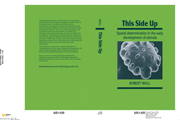Book contents
- Frontmatter
- Contents
- Preface
- Acknowledgements
- 1 Oogenesis
- 2 From oocyte to zygote
- 3 Does cleavage cut up a preformed spatial pattern?: the case of spiralian embryos
- 4 The limits of mosaicism in non-spiralian cleavage
- 5 Cellular interactions in the morula and blastula: the case of sea urchin embryos
- 6 Interactions at morula and blastula in other embryos
- 7 Interactions between moving cells: the case of amphibian gastrula
- 8 Spatial determination in the gastrulae of other groups
- 9 Determination in embryos showing partial cleavage
- 10 Patterns and mechanisms in early spatial determination
- References
- Index
3 - Does cleavage cut up a preformed spatial pattern?: the case of spiralian embryos
Published online by Cambridge University Press: 06 October 2009
- Frontmatter
- Contents
- Preface
- Acknowledgements
- 1 Oogenesis
- 2 From oocyte to zygote
- 3 Does cleavage cut up a preformed spatial pattern?: the case of spiralian embryos
- 4 The limits of mosaicism in non-spiralian cleavage
- 5 Cellular interactions in the morula and blastula: the case of sea urchin embryos
- 6 Interactions at morula and blastula in other embryos
- 7 Interactions between moving cells: the case of amphibian gastrula
- 8 Spatial determination in the gastrulae of other groups
- 9 Determination in embryos showing partial cleavage
- 10 Patterns and mechanisms in early spatial determination
- References
- Index
Summary
Cleavage is the process which divides the zygote into many cells: cells, moreover, of a more normal size, and with a more normal ratio of cell size to nuclear size. Division is usually rapid with almost all of the interphase time being occupied by replication of the DNA, and that itself occurring very fast using closely packed DNA polymerase molecules (Callan, 1973). The divisions are mitotic, using a spindle organised by a pair of centrioles originating usually from the sperm. Asters determine where cleavage will occur, but it is a band of cortical microfilaments which actually constricts the cell (for review see Rappaport, 1971). Cycles are commonly detected in nuclear, cortical and general cytoplasmic properties (see references in Satoh, 1982b). It is probably an oscillating cytoplasmic factor which ensures that all these cycles are precisely synchronised in normal cleavage (Yoneda & Schroeder, 1984). Activities which oscillate in the cleavage cycle include maturation promoting factor (MPF) and an inactivator of MPF (Gerhart, Wu & Kirschner, 1984a; see also Evans et al., 1983), and, since the artificial addition and removal of MPF can drive the mitotic cycle of Xenopus eggs (Newport & Kirschner, 1984a), they seem to play a key role in the oscillation process.
We have seen in the last chapter that developmentally important materials do become differentially distributed in many maturing oocytes and zygotes.
- Type
- Chapter
- Information
- This Side UpSpatial Determination in the Early Development of Animals, pp. 68 - 95Publisher: Cambridge University PressPrint publication year: 1990



